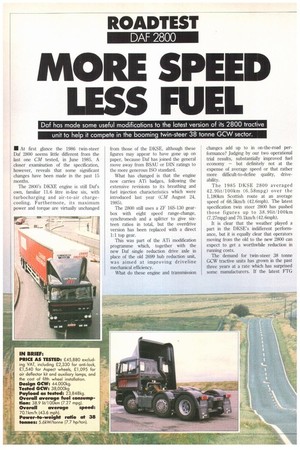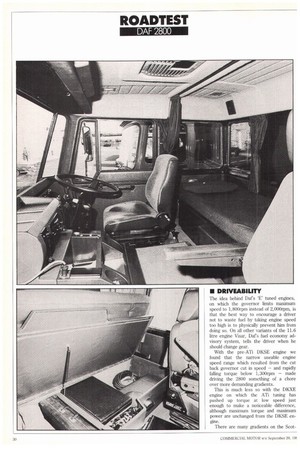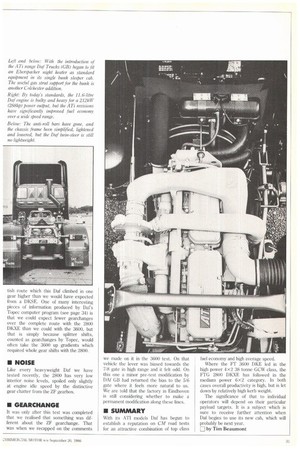MORE SPEED LESS FUEL
Page 30

Page 31

Page 32

Page 33

If you've noticed an error in this article please click here to report it so we can fix it.
Daf has made some useful modifications to the latest version of its 2800 tractive unit to help it compete in the booming twin-steer 38 tonne GCW sector.
• At first glance the 1986 twin-steer Daf 2800 seems little different from the last one CM tested, in June 1985. A closer examination of the specification, however, reveals that some significant changes have been made in the past 15 months.
The 2800's DICE engine is still Dafs own, familiar 11.6 litre in-line six, with turbocharging and air-to-air chargecooling. Furthermore, its maximum power and torque are virtually unchanged from those of the DKSE, although these figures may appear to have gone up on paper, because Daf has joined the general move away from BSAU or DIN ratings to the more generous ISO standard.
What has changed is that the engine now carries ATi badges, following the extensive revisions to its breathing and fuel injection characteristics which were introduced last year (CM August 24, 1985).
The 2800 still uses a ZF 16S-130 gearbox with eight speed range-change, synchromesh and a splitter to give sixteen ratios in total, but the overdrive version has been replaced with a direct 1:1 top gear.
This was part of the ATi modification programme which, together with the new Daf single reduction drive axle in place of the old 2699 hub reduction unit, was aimed at improving driveline mechanical efficiency.
What do these engine and transmission changes add up to in on-the-road performance? Judging by our two operational trial results, substantially improved fuel economy — but definitely not at the expense of average speed or that rather more difficult-to-define quality, driveability.
The 1985 DKSE 2800 averaged 42.91it/100km (6.58mpg) over the 1,180km Scottish route at an average speed of 68.51un/h (42.6mph). The latest specification twin steer 2800 has pushed those figures up to 38.91it/100km (7.27mpg) and 70.11un/h (42.6mph).
It is clear that the weather played a part in the DKSE's indifferent performance, but it is equally clear that operators moving from the old to the new 2800 can expect to get a worthwhile reduction in running costs.
The demand for twin-steer 38 tonne GCW tractive units has grown in the past three years at a rate which has surprised some manufacturers. If the latest FTG Daf is to hold or improve its share of this increasingly-competitive sector it needs to stand comparison not only against earlier Daf models.
Most of the first generation 6x 2 tractive units, many of which seemed to have been designed or modified to suit the new regulations in some haste, have now been replaced by more refined vehicles, which provide the Daf with a lot of stiff competition.
Of those that CM has tested to date, the Renault G290 (CM August 23) is outstanding on fuel economy, but as our histograms show it cannot quite match the Dafs journey times. A question that arises from such a comparison is, which vehicle is the more productive? In order to answer that, payload, average speed and fuel consumption all have to be considered. If the first factor (tonnes) is multiplied by the second (km/h), and the product divided by fuel consumption in lit/100km we have a measure of productivity. On that basis the Renault scores 46.10 against the Daf s 42.98.
The Renault's remarkably low kerb weight, a full tonne less than the Dafs, combined with its excellent fuel economy to more than outweigh its relatively sluggish pace.
Yet on the same basis the FTG2800 comes out with flying colours from a comparison with tractive units widely regarded as the pacesetters in productivity terms. The ERF R Series 6 x2, for example (CM May 10) scores 40.1 while even the day cabbed-ERF with the LTA 10 Currunins engine, which always does so well in trials like last weekend's BTAC event, can manage only 42 on the productivity index.
• WEIGHTSAVING
As we pointed out in the FT 3600Dla test earlier this year (CM January 4), low weight has never been a Dal strong point, but as with its top-of-the-range 4 x 2, Daf Trucks (GB) has done what it can to keep the payload of its twin-steer from falling too far behind its rivals. A simpler, lighter chassis frame with a shorter rear overhang was introduced late last year at the same time as 11R22.5 tyres became standard equipment in place of the heavier 12R22. 5s. Nevertheless, our test vehicle weighed in at well over eight tonnes, despite its Aspect aluminium alloy wheels (the same type as those fitted to the tested FT3(i00).
• BRAKING
One aspect of this Dafs test performance — braking — is difficult to fault. Our rolling road brake test showed an all-too-rare good balance between braking effort on the front and rear axles and, as expected with a combination of Wabco anti-lock on the tractive unit and Lucas Girling Skidchek on the trailer, our track brake tests were pleasingly unexciting.
The action of the Daf foot brake valve is smooth and progressive, allowing close control over check braking. The FTG 2800's brakes do not completely escape criticism, however. Quite a severe front brake judder became apparent when slowing from about 961un/h and, as is so often the case, the exhaust brake is a lot less effective than we would like.
• RIDE AND HANDLING
Another recent weightsaving measure on the 6x2 Daf is the deletion of anti-roll bars. Knowing this we paid particular attention to this vehicle's behaviour when cornering but there was no sign of excessive roll.
With air suspension on the second steer and drive axle, the Daf coped noticeably better with the exceptional flexing of our tandem axle trailer, with its bogie mounted at the extreme rear, than do mechanically suspended twin steers such as the ERF E-Series.
• DRIVEABILITY
The idea behind Des 'E' tuned engines, on which the governor limits maximum speed to 1,800rpm instead of 2,000rpm, is that the best way to encourage a driver not to waste fuel by taking engine speed too high is to physically prevent him from doing so. On all other variants of the 11.6 litre engine Visar, Oaf's fuel economy advisory system, tells the driver when he should change gear.
With the pre-ATi DKSE engine we found that the narrow useable engine speed range which resulted from the cut back governor cut in speed — and rapidly falling torque below 1,300rpm — made driving the 2800 something of a chore over more demanding gradients.
This is much less so with the DKXE engine on which the ATi tuning has pushed up torque at low speed just enough to make a noticeable difference, although maximum torque and maximum power are unchanged from the DKSE engine.
There are many gradients on the Scot tish route which this Daf climbed in one gear higher than we would have expected from a DKSE. One of many interesting pieces of information produced by Dais Topec computer program (see page 34) is that we could expect fewer gearchanges over the complete route with the 2800 DKXE than we could with the 3600, but that is simply because splitter shifts, counted as gearchanges by Topec, would often take the 3600 up gradients which required whole gear shifts with the 2800.
• NOISE
Like every heavyweight Daf we have tested recently, the 2800 has very low interior noise levels, spoiled only slightly at engine idle speed by the distinctive gear chatter from the ZF gearbox.
• GEARCHANGE
It was only after this test was completed that we realised that something was different about the ZF gearchange. That was when we recapped on the comments we made on it in the 3600 test. On that vehicle the lever was biased towards the 7/8 gate in high range and it felt odd. On this one a minor pre-test modification by DAf GB had returned the bias to the 5/6 gate where it feels more natural to us. We are told that the factory in Eindhoven is still considering whether to make a permanent modification along these lines.
• SUMMARY
With its AT! models Daf has begun to establish a reputation on CM road tests for an attractive combination of top class
fuel economy and high average speed.
Where the FT 3600 DKE led in the high power 4 x2 38 tonne GCW class, the F'I'G 2800 DKXE has followed in the medium power 6 x 2 category. In both cases overall productivity is high, but is let down by relatively high kerb weight.
The significance of that to individual operators will depend on their particular payload targets. It is a subject which is sure to receive further attention when Daf begins to use its new cab, which will probably be next year.
by Tim Beaumont
























































































































